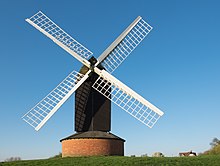
Back Stubmølle Danish Bockwindmühle German Pivota muelejo Esperanto Pukktuulik Estonian Varvasmylly Finnish Moulin sur pivot French Standermole Frisian Stoandermölle NDS-NL Standerdmolen Dutch Koźlak (wiatrak) Polish

The post mill is the earliest type of European windmill. Its defining feature is that the whole body of the mill that houses the machinery is mounted on a single central vertical post. The vertical post is supported by four quarter bars. These are struts that steady the central post.
The body of the windmill can be turned around the central post to bring the sails into the wind. All post mills have an arm projecting from them on the side opposite the sails and reaching down to near ground level. With some, as at Saxtead Green, the arm carries a fantail to turn the mill automatically. With the others the arm serves to rotate the mill into the wind by hand.
The earliest post mills in England are thought to have been built in the 12th century. The earliest working post mill in England still used today is to be found at Outwood, Surrey. It was built in 1665. The earliest remaining example of a non-operational mill can be found in Great Gransden in Cambridgeshire, built in 1612.[1] Their design and usage peaked in the 18th and 19th centuries and then declined after the introduction of high-speed steam-driven milling machinery.[2] Many still exist today, primarily in Northern Europe and Great Britain. The term peg mill or peg and post mill (in which the "post" was the tailpole used to turn the mill into the wind) was used in north-west England, and stob mill in north-east England, to describe mills of this type.
Post mills dominated the scene in Europe until the 19th century when tower mills began to replace them.[3] The advantage of the tower mill over the earlier post mill is that it is not necessary to turn the whole mill ("body", "buck") with all its machinery into the wind; this allows more space for the machinery as well as for storage.